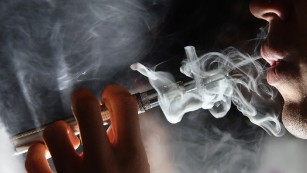Dripping produces thicker clouds of vapor, gives a stronger sensation in the throat and makes flavors taste better, according to a study, published Monday in the journal Pediatrics.
“This study is the first systematic evaluation of the use of dripping among teens,” said Suchitra Krishnan-Sarin, lead author and a professor in the department of psychiatry at the Yale University School of Medicine.
Krishnan-Sarin and her colleagues surveyed teens from eight southeastern Connecticut high schools during spring 2015.
Though some respondents did not answer all the questions, 1,874 students reported having tried an e-cigarette. More than 26% of those who’d tried vaping also reported dripping.
Being male, being white, having tried more tobacco products and using e-cigarettes on a greater number of days over the previous month were the traits likely to be associated with dripping.
What is dripping?
E-cigarettes heat liquid and turn it into vapor, which a user inhales and then exhales in a large puffy cloud.
The normal process of vaping relies on an e-cig’s reservoir and wick, both of which automatically feed liquid to the heating coil within the device, minus any effort or intervention on the part of the user.
Aficionados sometimes prefer to bypass the usual battery-operated process and substitute a more hands-on approach — essentially an artisanal version of vaping.
“Dripping is a more labor-intensive method of vaping in which the user manually applies a few drops of liquid directly to the exposed heating coil of the e-cig every so many puffs,” said Alan Shihadeh, a professor of mechanical engineering and director of the Aerosol Research Laboratory at the American University of Beirut.
Shihadeh, a project leader at the Center for the Study of Tobacco Products of Virginia Commonwealth University, was not involved in the new study.
Along with a better cloud, more flavor and a stronger hit, Shihadeh said, some people prefer dripping because “it allows them to conveniently change from one liquid flavor to another without wasting liquid.”
Ray Story, CEO of the Tobacco Vapor Electronic Cigarette Association, an industry group, suspects the number of teens who have tried dripping may not be as high as the study indicates.
“Do we think it’s going to become a trend or very popular? No,” he said. Story, who was not involved in the study, believes there will always be an extreme group that uses any product, including e-cigarettes, in alternative ways.
Story favors regulation and dislikes the fact that underage teens are vaping. Still, he said that ‘it’s much better to have them play around with vaping devices versus conventional tobacco,” a product he believes is more harmful to health than e-cigarettes.
Toxic emissions
Dripping generates higher heating coil temperatures than conventional use of e-cigarettes — and this is a safety concern. “Higher temperatures lead to greater emissions of a class of harmful chemicals known as volatile aldehydes,” including formaldehyde and acrolein, Shihadeh said.
According to
Dr. David Carpenter, director of the University at Albany’s School of Public Health, both formaldehyde and acrolein are known to cause cancer in humans. Carpenter is unaffiliated with the new study.
In an
unrelated study last year, Shihadeh and his colleagues approximated realistic dripping scenarios under laboratory conditions and then measured temperatures and emissions. “The aldehyde emissions were much greater than what we measured using conventional e-cigs,” he said.
More important, as puffing progresses and liquid is consumed, the temperatures and emissions rise “drastically,” Shihadeh said. Users believe they can detect when conditions have shifted by a change in flavor, he explained, but by the time they “taste the difference, they very likely have already been exposed to much higher levels of these toxicants” than would have happened under conventional e-cig use.
According to Krishnan-Sarin, “Emerging data is also showing that e-cigarettes contain many other chemicals like propylene glycol and glycerine, and they also contain a lot of flavor chemicals. Now, all of these are volatile, and when they are heated at high temperatures like we see with dripping, you could produce high levels of carcinogenic compounds.
“If the e-liquid is vaporized at a high temperature, you could get a big shot of nicotine,” Krishnan-Sarin said.
However, inhaling toxic chemicals is not the only safety risk.
“Handling liquid so often, there is a greater risk of incidental skin contact,” Shihadeh said. E-cigarette liquids typically contain nicotine, which is absorbed rapidly through human skin.
If enough liquid is spilled, then, a vaper could be exposed to toxic levels of nicotine. Shihadeh also suggested young children might be hurt by spilled liquid. An analysis of calls to the
National Poison Data System estimated that more than seven young children accidentally ingest e-liquids left within reach in households each day.
Revisiting the past
“The other thing is, nicotine is addictive,” Carpenter said. “What I’m primarily concerned about is, they’ve become so popular with the kids, and they’re going to be just as addictive as cigarettes.”
Their popularity among teens is no longer in question. A December report from Surgeon General Vivek Murthy found e-cigarettes are now “the most commonly used form of tobacco among youth in the United States, surpassing conventional tobacco products, including cigarettes, cigars, chewing tobacco and hookahs.” In fact, use of e-cigarettes among high school students increased by 900% from 2011 to 2015, according to the report.
Carpenter worries about the possibility of addiction because the devices are promoted as being safer than conventional cigarettes. Many people, though, do not understand that the fun-flavored liquids — including “mango” and “bubble gum” — often contain nicotine. Since nicotine levels also vary from formulation to formulation, users may unknowingly develop a strong need to vape more frequently.
Though it is true that e-cigarettes lack many of the toxic chemicals contained in regular cigarettes, said Carpenter, they have instead “all these added things: these flavorings, these other chemicals.” E-cigarettes are unknown territory when it comes to human health, he said.
Krishnan-Sarin agrees: “What I always tell parents is that we know very little, I think, about the short and long-term effects of e-cigarettes.”
Meanwhile, the Food and Drug Administration identified 134 incidents of e-cigarette batteries overheating, catching fire or exploding in the United States during a seven-year period ending in January 2016.
In light of the many health concerns, the FDA announced last year that it would regulate e-cigarettes the same way it regulates traditional cigarettes and smokeless tobacco.
This spring, the agency’s Center for Tobacco Products will host a
workshop in April to “gather information and stimulate discussion” about e-cigarette battery safety concerns.
Currently, a
public docket is open to anyone who wishes to comment on the topic.
Join the conversation
See the latest news and share your comments with CNN Health on Facebook and Twitter.
Beyond dripping is another alternative use of e-cigarettes that is of concern to Krishnan-Sarin: smoke tricks.
“You can inhale the vapor or the aerosol, and then you blow it out of your mouth or nose, and you create all different kinds of shapes,” she said. “People create dragons and volcanoes and little hearts.” Vape fests and competitions are devoted to smoke tricks, which are becoming enormously popular.
“More study is needed,” said Krishnan-Sarin. “We can’t just assume e-cigarettes are being used the way everybody thinks they’re being used.”
By Susan Scutti, CNN Updated 8:57 AM ET, Tue February 7, 2017















